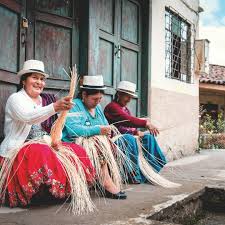Imagine starting your day with a dish that connects you to the heart of Ecuadorian culture. Meet motepillo, a traditional Ecuadorian delicacy that has been a staple in the highlands of Ecuador. With its blend of hominy corn and scrambled eggs, this dish is a taste of Ecuador’s rich culinary heritage.
For travelers and food enthusiasts alike, discovering motepillo is like uncovering a hidden gem. This dish is made from hominy corn sautéed with onions, garlic, and achiote, then mixed with eggs and milk. It offers a unique combination of flavors and textures that is both comforting and satisfying. Whether you’re enjoying it as a hearty breakfast or a light lunch, motepillo is sure to leave a lasting impression.
At Hotel Boutique Mansión Alcázar, we take pride in offering our guests an authentic taste of Ecuadorian cuisine. Our chefs prepare motepillo using traditional methods, ensuring that each bite captures the essence of this beloved dish. As you savor the flavors, you’ll travel back in time, experiencing the elegance and distinction of Cuenca’s golden years.
In this blog post, we’ll delve into everything you need to know about motepillo. From its origins and cultural significance to a step-by-step guide on how to prepare it at home. So, whether you’re planning your next trip to Ecuador or simply looking to expand your culinary horizons, join us. Let’s start!
The Rich History of Motepillo
The origins of motepillo are deeply intertwined with the cultural and historical tapestry of Ecuador, particularly within the highlands region. This traditional dish has been a staple in Ecuadorian cuisine for centuries, reflecting the culinary ingenuity of the indigenous people.
Motepillo’s history goes back to the pre-Columbian era. Where hominy corn, known as ‘mote’, was a fundamental part of the Andean diet. The process of nixtamalization, soaking and cooking the corn in an alkaline solution, enhance the nutritional value and flavor of the corn. This method not only made the corn easier to grind but also increased its protein content and reduced toxins. Making it a vital food source for the indigenous communities.
Origins and Evolution
The dish evolved over time, incorporating ingredients. Such as eggs, onions, garlic, and achiote, from the Spanish colonization. The combination of these ingredients with hominy corn resulted in the creation of motepillo. A dish that quickly became popular among the local population. Historical accounts suggest that motepillo was common during harvest festivals and community gatherings, symbolizing abundance and unity.
Local anecdotes and historical records highlight the significance of motepillo in the daily lives of Ecuadorians. For instance, during the colonial period, motepillo was a common breakfast for workers in the highlands. It provided them with the necessary energy to start their day. Over the years, the dish has maintained its popularity, becoming a beloved comfort food for many Ecuadorians.
Significance in Local Traditions and Festivals
Motepillo holds a special place in various Ecuadorian traditions and festivals. In the city of Cuenca, where the dish is particularly renowned, motepillo is often featured in local celebrations. The festival which commemorates the founding of the city, for example. It showcases traditional music, dance, and cuisine, with mote pillo being a highlight of the culinary offerings.
Quotes from local historians emphasize the cultural importance of motepillo. As one historian notes, “Motepillo is more than just a dish. It is a symbol of our heritage and a testament to the resilience and creativity of our ancestors.” This sentiment is echoed by many Ecuadorians. They see motepillo as a connection to their roots and a celebration of their cultural identity.
Motepillo in Modern Times
Today, motepillo continues to be a cherished dish in Ecuadorian households and restaurants. Its simple yet flavorful ingredients make it a versatile dish that can be enjoyed at any time of the day. In modern Ecuadorian cuisine, motepillo is often served with accompaniments such as queso fresco and hot black coffee.
As Ecuadorians migrate and settle in different parts of the world, they bring with them the traditions. Including flavors of their homeland, like motepillo. This dish has found its way into international kitchens, where it is appreciated for its rich history and delicious taste. For travelers visiting Ecuador, experiencing motepillo is a must. Offering a taste of the country’s culinary heritage and a glimpse into its vibrant culture.
Ingredients and Preparation of Motepillo
The ingredients and preparation methods of motepillo are simple yet flavorful. This section will provide a detailed guide on the necessary ingredients. From step-by-step preparation instructions to tips for achieving the perfect dish.
Motepillo, a traditional Ecuadorian dish, is known for its delightful combination of hominy corn and scrambled eggs. To create this dish, you’ll need a few key ingredients and follow some straightforward steps. Let’s dive into the details.
Essential Ingredients
To make authentic motepillo, gather the following ingredients:
- 1 lb cooked hominy (mote). – You can use canned hominy or prepare it from scratch by soaking and cooking dried hominy.
- 2 tablespoons butter – For sautéing the ingredients.
- 4 eggs – Beaten, to be mixed with the hominy.
- 1 cup diced white onion – You can also use spring onions or leeks.
- 2 garlic cloves – Crushed, for added flavor.
- 1/4 teaspoon ground achiote – This gives the dish its characteristic color and flavor.
- 1/4 cup milk – To add creaminess.
- 2 tablespoons chopped chives or scallions – For garnish.
- 1 tablespoon finely chopped cilantro or parsley – For garnish.
- Salt to taste – To enhance the flavors.
Step-by-Step Preparation
Follow these steps to prepare motepillo:
- Heat the butter over medium heat in a large sauté pan. Add the diced onions, crushed garlic, ground achiote, and a pinch of salt. Cook until the onions are soft, about 5 minutes.
- Add the hominy to the pan. Stir well and cook for another 2 minutes, allowing the flavors to meld.
- Pour in the milk and cook until it is almost fully absorbed by the hominy, stirring occasionally.
- Whisk the eggs and add them to the hominy mixture. Stir continuously to ensure the eggs are evenly distributed and cook for about 3-5 minutes until they are set.
- Garnish with chopped chives, cilantro, and additional salt if needed. Serve hot, accompanied by slices of queso fresco and a cup of hot black coffee.
Tips for Sourcing Authentic Ingredients
To achieve the best results, consider these tips:
- Hominy.: If you can’t find canned hominy, look for dried hominy in the ethnic or international section of your grocery store. Soak it overnight and cook it until tender.
- Achiote: This spice is essential for the authentic flavor and color of motepillo. You can find it in Latin American grocery stores or online.
- Fresh Herbs: Use fresh cilantro or parsley and chives to enhance the dish’s flavor and presentation.
By following these steps and tips, you’ll be able to prepare a delicious and authentic motepillo. Enjoy this comforting dish as a hearty breakfast or a satisfying meal at any time of the day.
Cultural Significance and Variations of Motepillo
Motepillo is more than just a dish; it holds deep cultural significance in Ecuadorian society. This traditional meal, made from hominy corn and scrambled eggs, is a staple in Ecuadorian cuisine, especially in the highlands. It reflects the agricultural practices, culinary ingenuity, and rich heritage of the indigenous people. Let’s explore the cultural importance of motepillo and the various regional variations that make it unique.
Cultural Importance of Motepillo
Motepillo is not just a meal but a symbol of Ecuadorian heritage. It is often served during important cultural events, family gatherings, and festivals. In the city of Cuenca, motepillo is a highlight during the Fiesta de Cuenca, which commemorates the city’s founding. This festival features traditional music, dance, and cuisine, with motepillo being a central dish that brings people together.
Historically, motepillo was a common breakfast for workers in the highlands. It was also prepared during harvest festivals, symbolizing abundance and unity. As one local historian notes, “Mote pillo is more than just a dish. It is a symbol of our heritage and a testament to the resilience and creativity of our ancestors.”
Regional Variations of Motepillo
While motepillo is enjoyed throughout Ecuador, different regions have their own unique twists on the dish. These variations reflect local tastes and traditions, making motepillo a versatile and beloved meal across the country.
- Cuenca.: motepillo is often prepared with a generous amount of achiote, giving it a vibrant color and rich flavor. It is typically served with slices of queso fresco and a cup of hot black coffee.
- Loja.: motepillo may include additional ingredients such as spring onions or leeks, adding a subtle sweetness. This variation is a favorite among locals and visitors alike.
- Quito.: motepillo is sometimes made with a touch of cumin and served with avocado slices. Providing a unique and modern twist on the traditional recipe.
These regional variations showcase the diversity of Ecuadorian cuisine. But also highlight the adaptability of motepillo to different local ingredients and preferences. Each version of motepillo tells a story of its region.
Modern Interpretations and Global Influence
As Ecuadorians migrate and settle in different parts of the world, they bring with them the traditions and flavors of their homeland, including motepillo. This dish has found its way into international kitchens, where it is appreciated for its rich history and delicious taste. Modern interpretations of motepillo may include variations with different herbs, spices, and accompaniments, reflecting the global influence on Ecuadorian cuisine.
For travelers visiting Ecuador, experiencing motepillo is a must. It offers a taste of the country’s culinary heritage and a glimpse into its vibrant culture. At Hotel Boutique Mansión Alcázar, guests can enjoy an authentic motepillo prepared using traditional methods, ensuring a genuine and memorable culinary experience.
Motepillo continues to be a cherished dish in Ecuadorian households and restaurants. Its simple yet flavorful ingredients make it a versatile dish that can be enjoyed at any time of the day. Whether you’re savoring it as a hearty breakfast or a comforting meal, motepillo is sure to leave a lasting impression.
Embrace the Flavor and Tradition of Motepillo
Motepillo is not just a dish; it’s a journey into the heart of Ecuadorian culture. From its origins in the Andean highlands to its modern-day variations, this traditional meal of hominy corn and scrambled eggs offers a deep connection to Ecuador’s rich culinary heritage. As we’ve explored, motepillo’s history is intertwined with the agricultural practices and festive traditions of the indigenous people, making it a symbol of unity and abundance.
For those eager to bring a taste of Ecuador into their own kitchens, the preparation of motepillo is straightforward yet deeply rewarding. By following our step-by-step guide, you can recreate this flavorful dish using authentic ingredients that capture the essence of Ecuadorian cuisine. Remember, the key to a perfect motepillo lies in sourcing quality hominy and spices, such as achiote, to ensure an authentic taste.
Here are some key takeaways from our exploration of motepillo:
- Historical Significance: Mote pillo dates back to pre-Columbian times, with hominy corn playing a crucial role in the Andean diet.
- Traditional Ingredients: The dish combines hominy corn with onions, garlic, achiote, eggs, and milk, garnished with chives and cilantro.
- Regional Variations: Different regions in Ecuador, such as Cuenca and Loja, have their unique twists on motepillo, reflecting local tastes and traditions.
- Modern Appeal: Motepillo continues to be a beloved dish, both in Ecuador and among the global Ecuadorian diaspora, appreciated for its simplicity and comforting flavors.
As you savor motepillo, you’re not just enjoying a meal but also participating in a cultural tradition that has been cherished for generations. We encourage you to explore more Ecuadorian dishes and delve deeper into the vibrant culinary landscape of this beautiful country. Visit our website for more recipes, travel tips, and cultural insights, and let your culinary adventures continue!




